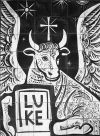
THE GOSPEL OF LUKE
John and the Crowds, Lk 3,7-14
These verses are notable because they are the same word for word in the Gospel of Matthew. The difference is the audience. Matthew addresses John's message to the Jewish leaders while in Luke, John gives the message to the whole crowd. Later (7,29-30), Luke makes clear who were baptized and that it was not accepted by the Pharisees and scribes.
Verse 3 tells us that John was proclaiming a baptism of repentance and fulfilling a prophet's role. Verse 8 outlines the conditions for repentance. Acts 3,25 from a speech of Peter also makes the link with Abraham but more positively.
Verses 10 to 14 are a response, the reaction "what shall we do?" is repeated three times (verses 10,12,14). That this is an important question for Luke is shown by the other three references, including Peter's Pentecost speech, Acts 2,37. Luke's interest in what we would call social justice is evident and will be a prominent theme through the Gospel. That may be why Luke has introduced this theme at this stage. John's message is similar to that of Jesus as we will see in verse 18.
The coming Messiah, Lk 3,15-18
Verse 15 reflects the sense of expectation of God once again intervening to save his people as he had done many times in the past. This is now centred on one particular saviour figure, the Messiah or Christ, God's anointed one.
John's reply stresses the superiority of the one who is to come. The sandal theme reappears in Acts 13,25, a speech by Paul. The contrast between the baptisms and the power of baptism in the name of Jesus is brought out in Acts 19,1-7 with a notable stress on the Holy Spirit (as in 3,16).
The conclusion of verse 18 is unique to Luke. He tells us that John preached good news, just as Jesus would do (4,18). "Good news" echoes Is 40,6, part of the same canticle as the earlier quotation, verses 4-6. The stress on social justice that we have seen (verses 10-14) is a good example of this.
The fate of John, Lk 3,19-20
The story of John's fate in these two verses is but an outline of the tale told by Mark. The immediate point is that Herod for one does not accept the good news being preached by John. The contrast is with the evil things that Herod had done. Here we are told that Herod put John in prison. Herod himself will say later that he beheaded John (9,9).
The mention here of Herod in these verses refers us back to Herod in verse 1. This repetition of Herod forms a bracket around these 20 verses. This is something which the evangelist does frequently as we have already seen.
Return now to the main page.
